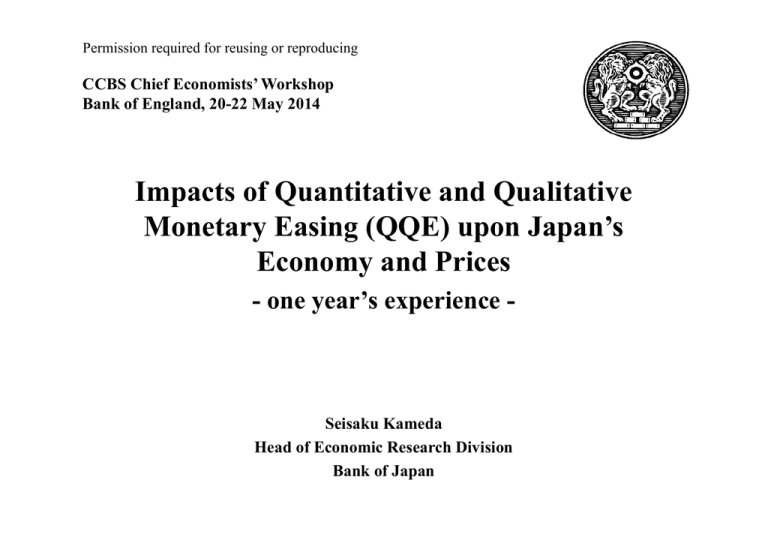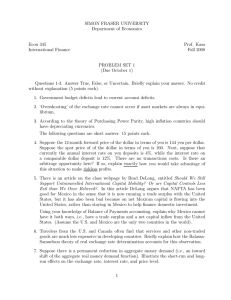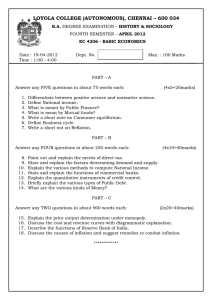QQE - Bank of England
advertisement

Permission required for reusing or reproducing CCBS Chief Economists’ Workshop Bank of England, 20-22 May 2014 Impacts of Quantitative and Qualitative Monetary Easing (QQE) upon Japan’s Economy and Prices - one year’s experience - Seisaku Kameda Head of Economic Research Division Bank of Japan Outline A. QQE : Japan’s Monetary Policy since last April B. Responses in Financial Markets C. Effects on the Real Economy D. Effects on the Price Front 1 A. QQE : Japan’s Monetary Policy since last April 2 A- QQE 1. Features of QQE (1) Massive Purchases of JGBs 320 tril. yen QQE announcement 280 240 End-2014 270 tril.yen Monetary base End-2013 202 tril.yen Amount outstanding of the Bank's JGB holdings 190 tril.yen 200 160 142 tril.yen 120 80 40 0 CY 07 Source: Bank of Japan. 08 09 10 11 12 13 14 15 3 A- QQE 2. Features of QQE (2) Dual Strong Commitments • The Bank will achieve the price stability target of 2 percent at the earliest possible time, with a time horizon of about 2 years. • The Bank will continue with the QQE as long as it is necessary for maintaining that target in a stable manner. 4 A- QQE 3. Features of QQE (3) Flexibility • The forward guidance implied in the QQE is state-contingent, or economic condition-based, but does not depend on a specific economic indicator like the unemployment rate. • The Bank will thoroughly examine both upside and downside risks to economic activity and prices, and make adjustments as appropriate. 5 A- QQE 4. Features of QQE (4) Coordination with the Government Policy - Joint Statement in January 2013 • The Bank of Japan conducts monetary policy based on the principle that the policy shall be aimed at achieving price stability. • The Government will not only flexibly manage macroeconomic policy but also formulate measures for strengthening competitiveness and growth potential of Japan's economy. • In addition, in strengthening coordination between the Government and the Bank of Japan, the Government will steadily promote measures aimed at establishing a sustainable fiscal structure with a view to ensuring the credibility of fiscal management. 6 A- QQE 5. Three Transmission Channels of QQE (1) Asset Prices Channel Lowering risk premia of various asset prices including long-term interest rates (2) Portfolio Rebalance Channel Enhancing investment in risk assets in the private sector (3) Expectations Channel Raising people’s inflation expectations 7 B. Responses in Financial Markets 8 B- Responses in Financial Markets 1. Rise in Stock Prices 180 Jan. 2005=100 180 Japan (Nikkei 225 Stock Average) United States (Dow Jones Industrial Average) Europe (EURO STOXX) 160 160 140 140 120 120 100 100 Target of 2% announcement 80 80 QQE announcement 60 CY05 06 Source: Bloomberg. 07 08 09 10 11 12 13 14 12/ 10 13/ 1 4 7 10 14/ 1 60 4 9 B- Responses in Financial Markets 2. Depreciation of the Yen 180 70 150 Depreciation of the yen 140 160 80 130 Appreciation of the yen 140 120 90 120 110 100 100 100 90 110 Yen/U.S. dollar (left scale) 80 Yen/U.S. dollar Yen/euro (left scale) Real effective exchange rate of the yen (right scale, CY2010=100) 60 120 CY 0 5 0 6 0 7 0 8 0 9 1 0 1 1 1 2 1 3 14 80 Yen/euro 12/ 10 13/1 4 7 10 14/ 1 Note: Figures for real effective exchange rate of the yen are based on the broad index of the BIS effective exchange rate. The figure for April 2014 has been calculated using the monthly average of the BOJ's nominal effective exchange rate (the Yen Index). Sources: Bloomberg; BIS. 70 4 10 B- Responses in Financial Markets 3. Stability in Long-Term Interest Rates 6 % % 3.5 Japan United States 5 3.0 Germany 2.5 4 2.0 3 1.5 2 1.0 1 0 CY05 0.5 Testimony by Chairman Bernanke 06 07 08 09 Sources: Japan Bond Trading Co., Ltd.; Bloomberg. 10 11 12 13 14 12/ 13/ 10 1 4 7 14/ 10 1 0.0 4 11 B- Responses in Financial Markets 4. Factors behind Long-Term Interest Rates % 2.0 1.8 Depressing Factor Purchase of JGBs by BOJ 1.6 1.4 1.2 LongTerm Interest Rate = Expected Short-Term Interest Rates + Risk Premium 1.0 0.8 0.6 Rising Factor Improvements in outlook for economic activity and prices 0.4 10-year forward rate 3 years from now 0.2 spot rate 0.0 12/10 Source: Bloomberg. 13/01 13/04 13/07 13/10 14/01 14/04 12 B- Responses in Financial Markets 5. Decline in Real Interest Rates 4 % 4 3 3 2 2 1 1 0 0 -1 -1 -2 -2 Inflation-indexed JGB (old, the longest maturity) Inflation-indexed JGB (old, 10 year) JGB (5 year) - Inflation swap (5 year) -3 % -3 Inflation-indexed JGB (new, 10 year) -4 -4 CY 05 06 Source: Bloomberg. 07 08 09 10 11 12 13 14 CY 05 06 07 08 09 10 11 12 13 14 13 B- Responses in Financial Markets 6. Money and Credit Money Stock and Bank Lending 10 y/y % chg. Financial Position of Enterprises 36 32 M2 8 DI "Easy" 28 Lending by domestic commercial banks 24 6 "Tight" Large enterprises Small enterprises 20 16 4 12 8 2 4 0 0 -4 -2 -8 -12 -4 -16 -20 -6 -24 -8 CY 95 97 99 Source: Bank of Japan. 01 03 05 07 09 11 13 14 -28 CY 85 87 89 91 93 95 97 99 01 03 05 07 09 11 13 14 14 B- Responses in Financial Markets 7. Changes in Asset Portfolios of Private Sectors Households and Nonfinancial Corporations (tril.yen) -40 -20 0 20 Commercial Banks Insurance and Pension Funds (Depository Corporations) 40 -60 -30 0 30 -10 60 Bond, etc. Bond, etc. Bond, etc. Shares Shares Shares Deposits Loans Loans Outward investment Deposits with the BOJ Outward investment -5 0 5 10 Note: Figures indicate the cumulative flows from 2013/Q1 to 2013/Q4 recorded in “Flow of Funds Accounts.” Source: Bank of Japan. 15 C. Effects on the Real Economy C-1. The First Round Effect: Direct Effects from the Rise in Asset Prices 16 C-1 Effects on the real economy (1) 1. Recovery Led by Domestic Demand Private Consumption 320 Public Demand s.a., ann., tril. yen 130 310 125 300 120 290 115 280 110 CY0 5 0 6 100 07 s.a., ann., tril. yen 08 09 10 11 12 s.a., ann., tril. yen CY0 5 0 6 13 07 08 09 10 11 12 13 12 13 Business Investment Exports 80 90 s.a., ann., tril. yen 75 80 70 70 65 60 60 50 CY0 5 0 6 07 08 09 10 11 12 13 CY0 5 0 6 07 08 09 10 11 Note: In each chart, the broken line indicates the level for 2008/Q1, when real GDP recorded its peak just before the Lehman shock. Source: Cabinet Office. 17 C-1 Effects on the real economy (1) 2. Wealth Effect in Private Consumption Wealth Effect Simulation 2.0 deviation from the baseline, % Propensity to Consume by Age 140 Total effect % 130 Direct effect 1.5 120 110 1.0 CY 2000 CY 2005 CY 2013 100 90 0.5 80 70 0.0 -1 0 1 2 3 4 5 6 7 8 9 10 11 12 quarters 60 age - 2524 29 3034 3539 4044 4549 5054 5559 6064 6569 70+ Note: Response of private consumption to a 30 percent rise of TOPIX. Simulation based on Q-JEM. Sources: Ministry of Internal Affairs and Communications, etc. 18 C-1 Effects on the real economy (1) 3. Improvements in Business Confidence and Profits Large Manufacturing Enterprises 30 % DI 10 20 8 10 6 0 4 -10 2 -20 0 -30 -2 -40 -4 -50 -6 -60 -70 -80 CY 00 Business conditions ("favorable" - "unfavorable," left scale) 06 08 Sources: Bank of Japan; Ministry of Finance. 10 % DI 5.0 10 4.5 0 4.0 -10 3.5 -20 3.0 -30 2.5 -40 2.0 -50 CY 00 1.5 -10 -12 04 20 -8 Ratio of current profits to sales (right scale) 02 All Nonmanufacturing Enterprises 12 14 02 04 06 08 10 12 14 19 C-1 Effects on the real economy (1) 4. Effects of Yen’s Depreciation on Exports Increase in Foreign Visitors (Exports of Services) Real Exports of Goods 10 change from 2012/Q1 , % 3.5 Overseas economies factor Overseas economies factor Real effective exchange rate factor 3.0 Other factors 5 annualized change from 2009/Q1, millions Real exports 2.5 Real effective exchange rate factor Other factors 2.0 0 1.5 1.0 -5 0.5 0.0 -10 12/Q2 3 4 13/1 2 3 4 Note: An estimated decomposition. Other factors include structural changes caused by the shift to overseas production and the decrease in non-price competitiveness. Sources: Ministry of Finance; Bank of Japan; IMF; JNTO, etc. 12/Q1 2 3 4 13/1 2 Note: An estimated decomposition. Other factors include structural changes caused by the easing of visa requirements and the introduction of visa exemptions. 20 C-1 Effects on the real economy (1) 5. Real Interest Rate Gap and Investment Activities Output Gap and Real Interest Rate Gap -8 Cross Correlations between Real Interest Rate Gap and Fixed Investment % reversed, % 8 0.8 Real interest rate gap (left scale) -6 6 0.6 -4 4 0.4 -2 2 0.2 0 0 0 2 -2 -0.2 4 -4 -0.4 6 -6 -0.6 8 CY83 86 -8 -0.8 Output gap (right scale) 89 92 95 98 01 04 07 10 13 Notes: 1. Real interest rate gap = Real short-term interest rate - Potential growth rate (1 year ahead) Notes: 2. Real short-term interest rate = Overnight call rate - CPI less fresh food (y/y % chg., 1 year ahead) Sources: Cabinet Office, etc. Real Interest rate gap ←Leading Lagging→ Private Residential Investment Private Non-Residential Investment -12 -10 -8 -6 -4 -2 0 2 4 6 8 10 12 quarters 21 C-2. The Second Round Effect: the Knock-on Effect on Employment and Households’ Income 22 C-2 Effects on the real economy (2) 1. Transition in the Mechanism of Business Cycles Ratio of Domestic Demand to Nominal GDP Notes:1. Shaded areas indicate recession periods. 2. Figures up through 1979 are on the 1990 base. Figures from 1980 up through 1993 are on the 2000 base. Figures from 1994 onward are on the 2005 base. Source: Cabinet Office. 23 C-2 Effects on the real economy (2) 2. Relative Strength of Labor Market Indicators Industrial Production 120 Unemployment Rate CY 2010=100 3 reversed, % 115 110 105 4 100 95 90 5 85 80 75 CY 9 8 00 02 04 06 08 10 12 14 6 CY 9 8 00 02 04 06 08 10 12 14 Note: Shaded areas indicate recession periods. The broken line indicates the level of the latest peak/bottom. Sources: Ministry of Economy, Trade and Industry; Ministry of Internal Affairs and Communications. 24 C-2 Effects on the real economy (2) 3. Responses to Consumption and Export Shocks Manufacturing Real Value-Added 14 Nonmanufacturing Real Value-Added deviation from the baseline, % points 12 10 8 6 4 Comsumption shock 2 Export shock 0 1 3.5 2 3 4 5 6 7 Employment 8 1 9 10 quarters deviation from the baseline, % points 2 3 4 5 6 Employment 7 8 9 10 quarters 7 8 9 10 quarters deviation from the baseline, % points 0.8 3.0 0.6 2.5 2.0 0.4 1.5 0.2 1.0 0.0 0.5 -0.2 0.0 1 2 3 4 5 6 7 Note: Impulse responses from an estimated VAR. deviation from the baseline, % points 4.5 4.0 3.5 3.0 2.5 2.0 1.5 1.0 0.5 0.0 8 9 10 quarters 1 Sources: Cabinet Office; Ministry of Finance; Ministry of Internal Affairs and Communications. 2 3 4 5 6 25 C-2 Effects on the real economy (2) 4. Improvements in Employment and Income Situation Labor Force Participation Rates 75 s.a., % s.a., % Workers’ Income 50 3 % Number of workers Male (left scale) Female (right scale) 49 74 2 Average wages of fulltime workers 48 73 1 Average wages of parttime workers 47 72 46 71 0 Effect of rises in proportion of part-time workers -1 Workers' income: change from 2011/Q4 to 2013/Q4 70 CY 0 6 45 07 08 09 10 11 12 -2 1 3 14 Note: Q4 represents December-February here. Sources: Ministry of Health, Labour and Welfare; Ministry of Internal Affairs and Communications. 26 D. Effects on the Price Front D-1. The First Stage: Inflation due to the Rise in Import Prices 27 D-1 Effects on the Price Front (1) 1. Rise in Import Prices reflecting Yen’s Depreciation Import Prices and CPI less Fresh Food 170 160 150 CY2010 = 100 CY2010 = 100 IPI (yen basis, left scale) CPI (all items less flesh foods, right scale) Penetration of Imported Goods Capital goods 110 Consumption goods 109 108 140 107 130 106 120 105 110 104 100 103 90 102 80 101 70 100 60 99 50 98 CY 00 01 02 03 04 05 06 07 08 09 10 11 12 13 14 2000-04 2005-09 2010-14/Q1 10 15 20 20 5 % % Note: Import penetration ratio = imports / domestic shipments and imports 5 10 15 Sources: Ministry of Internal Affairs and Communications; Bank of Japan; Ministry of Economy, Trade and Industry. 28 D-1 Effects on the Price Front (1) 2. Energy Prices in CPI 10 y/y % chg. Implied direction given current levels of foreign exchange rates and oil prices 8 6 4 2 0 Petroleum products -2 Electricity and Gas, manufactured & piped CPI Energy -4 12/Jan. Apr. Jul. Oct. 13/Jan. Source: Ministry of Internal Affairs and Communications. Apr. Jul. Oct. 14/Jan. Apr. Jul. 29 D-2. The Second Stage: Inflation due to the Improvement in the Output Gap 30 D-2 Effects on the Price Front (2) 1. Widespread Increase of Consumer Prices CPI less Food and Energy 1.0 y/y % chg. 70 % 0.8 65 0.6 60 0.4 55 0.2 50 0.0 45 -0.2 40 -0.4 35 -0.6 30 -0.8 25 -1.0 20 CY 06 2013/Mar. 2014/Mar. Number of Increasing and Decreasing Items in CPI 07 08 09 10 11 12 13 14 Durable goods Semi/Non-durable goods Ratio of increasing items Public services House rent, private & imputed rent Ratio of decreasing items Other services CPI (all items less food and energy) Source: Ministry of Internal Affairs and Communications. Note: Proportion of items whose indices increased/decreased from a year earlier. All items less fresh food. 31 D-2 Effects on the Price Front (2) 2. Pass-through of Import Costs: Past and Present 40 % % 30 FY2008 1st half FY2008 2nd half FY2013 1st half FY2013 2nd half 4 3 20 2 10 1 0 0 -10 -1 IPI (contract currency basis) IPI (yen basis) CPI energy Sources: Bank of Japan; Ministry of Internal Affairs and Communications. CPI food CPI (less food and energy) 32 D-2 Effects on the Price Front (2) 3. Wage Inflation (1) Japan 35 US Hourly wage, y/y % chg. Hourly wage, y/y % chg. 10 1970's 1970's 1980's 1980's 30 1990's 25 1990's 8 2000- 2000- 20 6 15 4 10 5 2 0 -5 0 0 2 4 6 Unemployment rate, % 3 6 9 12 Unemployment rate, % Source: “An Empirical Study on the New Keynesian Wage Phillips Curve: Japan and the US,” Bank of Japan Working Paper Series, 14-E-4. 33 D-2 Effects on the Price Front (2) 4. Wage Inflation (2) Japan Estimation Results of NKW Philips Curve 1972-91 1973-92 1974-93 1975-94 1976-95 1977-96 1978-97 1979-98 1980-99 1981-00 1982-01 1983-02 1984-03 1985-04 1986-05 1987-06 1988-07 1989-08 1990-09 1991-10 1992-11 1993-12 1.0 0.8 0.6 0.4 0.2 0.0 -0.2 -0.4 -0.6 -0.8 -1.0 -1.2 1972-91 1973-92 1974-93 1975-94 1976-95 1977-96 1978-97 1979-98 1980-99 1981-00 1982-01 1983-02 1984-03 1985-04 1986-05 1987-06 1988-07 1989-08 1990-09 1991-10 1992-11 1993-12 α1 1.0 0.0 -1.0 -2.0 -3.0 -4.0 -5.0 -6.0 -7.0 -8.0 -9.0 US Hourly Waget log Hourly Wage t 4 Unemployment ratet 0 1 100 CPIt 1 2 log CPI t 5 0 1.5 1.2 1.0 0.8 0.6 0.4 0.2 0.0 -0.2 -0.4 α2 0.5 0.0 -0.5 1972-91 1973-92 1974-93 1975-94 1976-95 1977-96 1978-97 1979-98 1980-99 1981-00 1982-01 1983-02 1984-03 1985-04 1986-05 1987-06 1988-07 1989-08 1990-09 1991-10 1992-11 1993-12 -1.0 1 2 0.069 -1.560 0.396 (12.48) (-11.46) (4.72) Adj-R 2 0.800 United States 0 1972-91 1973-92 1974-93 1975-94 1976-95 1977-96 1978-97 1979-98 1980-99 1981-00 1982-01 1983-02 1984-03 1985-04 1986-05 1987-06 1988-07 1989-08 1990-09 1991-10 1992-11 1993-12 1.0 Japan 1 2 0.028 -0.191 0.529 (10.04) (-4.49) (17.56) Adj-R 2 0.697 Note: The estimation periods are 1980/Q1-2013/Q2. t-values in parentheses. Note: Rolling window is 20 years. Shaded area indicates the range of two standard errors. Source: "An Empirical Study on the New Keynesian Wage Phillips Curve: Japan and the US," Bank of Japan Working Paper Series, 14-E-4. 34 D-3. The Third Stage: Inflation due to the Rise in Inflation Expectations in Medium- to Long Terms 35 D-3 Effects on the Price Front (3) 1. Surveys on Inflation Expectations in Medium- to Long Terms 2.5 % Market Participants 2 to 10 years ahead 2.0 2.5 1.5 1.0 1.0 0.5 0.5 0.0 0.0 2011/Dec. 2.5 6 to 10 years ahead 2.0 1.5 Economists % 2012/Dec. 2014/Apr. 2011/Oct. Households % 2.5 Over the next 5 years 2.0 2.0 1.5 1.5 1.0 1.0 0.5 0.5 0.0 0.0 2011/Dec. 2012/Dec. 2014/Mar. % 2012/Oct. 2014/Apr. Enterprises 5 years ahead 2014/Mar. Notes: 1. The survey to market participants for April 2014 asked respondents to include the effects of scheduled consumption tax hikes. 2. The surveys to households and enterprises for March 2014 asked respondents to exclude the effects of scheduled consumption tax hikes. Sources: Bank of Japan; QUICK, etc. 36 D-3 Effects on the Price Front (3) 2. Changes in Distributions of Households’ Inflation Expectations 15 Density (%) Density (%) 15 16 Density (%) 2013 2012 12 10 10 8 5 5 4 0 0 0 -10 -5 0 5 5-year expectations 1-year expectations 10 15 -10 -5 0 5 10 15 -10 -5 0 5 10 15 5-year expectations (%) Respondents who knew about the "price stability target" Respondents who had not heard of the target Note: Circles indicate the mean of each distribution. Source: S. Nishiguchi, J. Nakajima, and K. Imakubo, 2014, “Disagreement in Households‘ Inflation Expectations and Its Evolution,” Bank of Japan Review Series 2014-E-1, Monetary Affairs Department, Bank of Japan. 37 D-3 Effects on the Price Front (3) 3. Shifts in Economists’ CPI Forecast 1.5 Fiscal 2013 y/y % chg. 1.0 0.5 CPI less fresh food (actual figures in the latest month) 0.0 -0.5 13/Apr. 1.5 Fiscal 2014 13/Jul. 13/Oct. 14/Jan. 14/Apr. y/y % chg. 1.0 Economists' Forecast of Fiscal 2014 0.5 BOJ Forecast of Fiscal 2014 0.0 -0.5 13/Apr. Sources: JCER; Bank of Japan. 13/Jul. 13/Oct. 14/Jan. 14/Apr. 38 D-3 Effects on the Price Front (3) 4. Existing Literature on the Formation of Inflation Expectations Japan Authors Nakayama and Oshima (1999) Tsuruga and Muto (2008) Data Consumer Confidence Survey Consumer Price Index, Output Gap Weights Estimation Periods Backward-looking Forward-looking 1971/Q2-1982/Q4 35% 65% 1983/Q1-1999/Q2 43% 57% 1971/Q2-2005/Q1 46% 54% United States Authors Data Weights Estimation Periods Backward-looking Forward-looking Michigan Survey 1966/Q2-1995/Q4 22-30% 70-78% Livingston Survey 1957/Q2-1995/Q2 21-38% 62-79% Galí and Gertler (1999) GDP Deflator, Unit Labor Cost 1960/Q1-1997/Q4 23-38% 62-77% Roberts (2001) GDP Deflator, Output Gap 1957/Q1-1997/Q4 47-67% 33-53% Kurmann (2007) GDP Deflator, Output Gap 1960/Q1-1997/Q4 45% 55% Roberts (1998) 39 D-3 Effects on the Price Front (3) 5. Term Structure of Inflation Expectations (1) Target Inflation Rate (4) Trend Inflation Rate - Defined as the ultra long-term expected inflation rate ("anchor" of expectation) - Not necessarily coincides with the target inflation rate Term Structure for period t+1 (2) Expected Inflation Rate - Formed by: (1) current and past inflation rates (backward-looking) (2) target inflation rate (forward-looking) Term Structure for period t 0 1 period ahead 2 periods ahead … n periods ahead Infinite period ahead (3) Actual Inflation Rate 40 D-3 Effects on the Price Front (3) 6. An Estimation of Trend Inflation Rate (1) TIPS : Trend Inflation Projection System 1 (1) 1 ,1 (2) , 1 , , 2 1 1 8 8 1 1 forwardlooking 1 backwardlooking (3) 1 , , 1 2 , 2 [ Remarks ] : inflation rate at period , , ∗ (1) is so-called Hybrid New Keyensian Phillips Curve : periods ahead expected inflation rate of at period : output gap at period : ∗ 2 - Formed by forward-looking term periods ahead expected output gap at period and backward-looking term : target inflation rate at period ,1 1 (2) formulates the term structure of expected inflation: By (1), (2) and (3), the trend inflation rate 1 8 lim →∞ , is given by - periods ahead expected inflation rate is formed by: (a) 8 1 1 ∗ 2 1 1 periods ahead expected inflation rate, (b) past inflation rates (backward-looking), and 1 (c) target inflation rate (forward-looking) 41 D-3 Effects on the Price Front (3) 7. An Estimation of Trend Inflation Rate (2) Case2: πt*= 1.5 percent (1990/Q1-2012/Q4), 2.0 percent (2013/Q1-2013/Q4) Case1: πt*= 2.0 percent (1990/Q1-2013/Q4) 3.0 ann. avg., % 3.0 ann. avg., % Expected inflation rate / 6 to 10 years ahead 2.5 TIPS / 6 to 10 years ahead 2.5 2.0 2.0 1.5 1.5 1.0 1.0 0.5 0.5 0.0 CY 90 95 Source: Bank of Japan, etc. 00 05 10 13 0.0 CY90 95 00 05 10 13 42 Summary Summary Asset Prices Channel Portfolio Rebalance Channel Economy First Round Effect Second Round Effect Inflation The First Stage The Second Stage QQE Expectations Channel The Third Stage 43 APPENDIX Appendix. BOJ Forecasts of Growth and Inflation Median of the Policy Board Members’ Forecasts y/y % chg. Real GDP Fiscal 2013 As of April 2013 Fiscal 2014 As of April 2013 Fiscal 2015 As of April 2013 Fiscal 2016 Source: Bank of Japan. CPI(all items less fresh food) Excluding the effects of the consumption tax hikes +2.2 +0.8 +2.9 +0.7 +1.1 +3.3 +1.3 +1.4 +3.4 +1.4 +1.5 +2.6 +1.9 +1.6 +2.6 +1.9 +1.3 +2.8 +2.1 44





